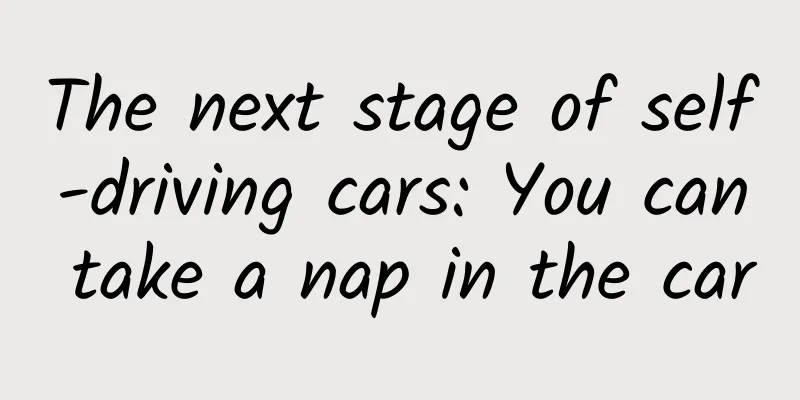The next stage of self-driving cars: You can take a nap in the car

|
According to foreign media reports, the problem with the current Level 2 autonomous driving technology is that the driver is required to be ready to take over the car at all times. In an emergency, the driver simply cannot notice when the system reaches its limit and cannot regain control of the vehicle. Researchers are studying the corresponding on-board sensor system so that the driver only needs to be ready to take over the control of the car when the car reminds him. You can imagine such a scene. You are driving a stylish semi-autonomous driving car along the highway, and you can hear the wheels humming under your feet. But when you enter the branch road, the autonomous driving system no longer works. The only trouble is that you have fallen asleep. Researchers believe that one day cars will be able to drive themselves completely autonomously. But for now, most so-called self-driving cars are only at Level 2, where the driver must handle several key aspects of the driving process. The main job of engineers is to figure out how to keep the driver alert. However, researchers say they are working on sensor-based systems to keep drivers alert and continue to move toward Level 3 autonomous driving technology, in which the driver is simply ready to intervene when the car asks. In a series of recent self-driving car accidents, Level 2 self-driving cars were in autonomous mode and the driver failed to take over in time. "When the autonomous driving system is running below Level 3, you can't fall asleep, you need to be ready to intervene at all times. But you don't need to drive all the time. You can work there, or relax. Going further, the system can tell you, 'You need to take over in 10 minutes'," said Anna Anund, a researcher at the Swedish National Road and Transport Research Institute who studies autonomous driving technology. By leveraging what we know about sleep, stress, human attention and anxiety, as well as weather and road conditions, Anund and his colleagues are working on a sensor-based system that can detect when a driving situation is dangerous and ensure that the driver can take over safely. It looks like this system will be very sophisticated. “It’s not going to spray water in your face,” said Anund, who specializes in developing automotive sensor systems. “If we’re talking about truck drivers, their main problem is that they drive on the highway for too long, which is very boring. Then the countermeasure of the sensor system may be to communicate with the driver and ask them to do something. If you are driving in the middle of the night, there is nothing that can help you except to stop.” The idea of a sensor system like this is far from science fiction: General Motors has already announced that its Cadillac Super Cruise self-driving technology will include eye tracking. But Anund said these systems could involve multiple types of sensors. “It’s not just retinal cameras,” she said. “On a motorcycle, we could have sensors in protective gear, like gloves, jackets, helmets. We could have sensors in the driver’s seat. This is not a sensor development project. These sensors exist. It’s about how to use them.” Anund added that the system could also reverse course if the sensors detect that the driver is drowsy or intoxicated. “That’s a critical situation for you and anyone coming in the opposite direction,” she said. Ian Reagan of the Insurance Institute for Highway Safety said it was important to work out the technical issues with semi-autonomous cars. “Any technology short of fully automated driving will create new challenges for the people on board. Studies have shown that, particularly in emergency situations, drivers are unable to notice when a system is reaching its limits and are unable to regain control of the vehicle.” He noted that Level 3 autonomous driving has inherent problems. “The driver has the right to direct their attention elsewhere, but must be ready to take over at any time,” he said. “The automated system needs to be programmed to seek a safe state on its own, such as automatically driving to the side of the road and stopping, rather than simply relying on the human driver to take over.” As a winner of Toutiao's Qingyun Plan and Baijiahao's Bai+ Plan, the 2019 Baidu Digital Author of the Year, the Baijiahao's Most Popular Author in the Technology Field, the 2019 Sogou Technology and Culture Author, and the 2021 Baijiahao Quarterly Influential Creator, he has won many awards, including the 2013 Sohu Best Industry Media Person, the 2015 China New Media Entrepreneurship Competition Beijing Third Place, the 2015 Guangmang Experience Award, the 2015 China New Media Entrepreneurship Competition Finals Third Place, and the 2018 Baidu Dynamic Annual Powerful Celebrity. |
>>: Dyson electric car details revealed: the first may be a performance sports car
Recommend
Didi's IPO: Revenue growth hits a ceiling, autonomous driving story is far from enough to quench thirst
As the undisputed top player in China's onlin...
“Justice League” that can save Android devices from lag is here!
The "Android Unified Push Alliance", wh...
12.12 is coming, please check out the wedding photography industry’s advertising secrets!
Following the popularity of 11.11, the 12.12 prom...
Uremia is mostly "made up"! Beware of these 6 behaviors that damage your kidneys
Recently, Master Wang, 42, from Taizhou, had to w...
Mosquito-repellent coil-shaped UFOs? No problem, we're old friends.
On the night of April 17 this year, the Hawaiian ...
The manned lunar landing drama is about to begin. Who has the ability to "occupy" the moon?
Two things happened recently. One was that NASA A...
IDC's top ten tablet predictions: 5G tablets are coming to the market, but the initial market remains to be seen
IDC pointed out that 5G tablets will be officiall...
As the entrance to 1 billion traffic, will mini-program games be the key?
Summarizing 2018, which is already halfway throug...
The iOS system has updated these things. Do you think they are great?
The official version of OS15 is finally here. Wha...
Marketing strategy for June: Children’s Day, College Entrance Examination, and Dragon Boat Festival, how to leverage marketing opportunities?
There are many festivals and hot topics in June e...
Where does the sun's energy come from, and will the fuel run out, causing it to become smaller and smaller and finally go out?
In a sense, the energy of the sun is inexhaustibl...
The folders on your phone are all in English, taking up memory but you dare not delete them. Here is how to delete junk files
Today I will teach you how to delete 4 English fo...
Apple and Samsung's market share has both declined. Why are domestic mobile phones rising?
In the first quarter of this year, Apple and Sams...
Air ticket blind box event operation routine!
As the trend of "everything is a blind box&q...
Price inquiry for the production of Changchun Hotel Mini Program. How much does it cost to produce Changchun Hotel Mini Program?
According to industry insiders, mini programs wil...









